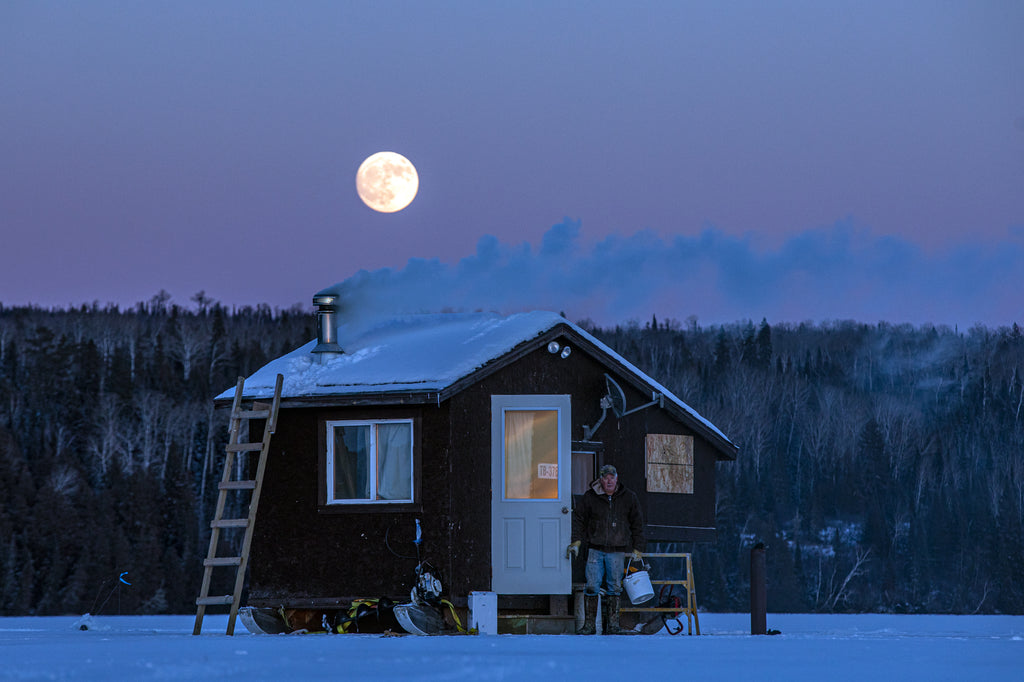Foreboding might be an understatement when one considers winter at northern latitudes.
Days are short, and the cold severe, yet there is a culture thriving amidst the sporadic blizzards; built atop frozen lakes and founded upon what swims below.
Ice huts, as they are commonly coined, are a beautiful, albeit precarious, phenomenon on freshwater lakes across Canada and the northern states of the US. With a little wood stove, a lot of gumption, and some backyard creativity, eager anglers find themselves inside tiny works of art in these quintessential cold weather fishing shelters.

Nestled into snowdrifts, tucked neatly under tiny plumes of smoke, colorful against a grey winters day, or sometimes buffeted by the seasons worst storm, these little shacks provide an oasis for those who possess a seasonless love for the outdoors, and don’t mind a little comfort.
On nights when the mercury hangs low, an ice shack becomes an amphitheater to the unseen workings of a freezing lake. Like the bellows of a great beast, ice moans and then roars, sometimes releasing thunderous cracks that reverberate across the silent night. Other times, when the stars are deep on a cold black night, you might stand in the doorway and gaze out, feeling the warmth of the stove on your back as the winter’s chill prickles at your cheeks.

Some ice huts don’t use a wood stove, instead small propane burners, just as some ice goers choose to fish, while others refer to their ice hut as simply winter camping and couldn’t be bothered to wet a line.
What makes ice huts precarious are the myriad scenarios that winter can deliver.
One needs to first construct a hut that is solid on wood skis to withstand the elements, comfortable enough to spend a day, a night, or a weekend, yet light enough to tow easily behind a snowmobile, ATV, or truck. Then there is the need for safe ice and only a combination of cold, snowless nights can bring the safe base that is needed to transport an ice hut.

Drving a smaller truck on ice requires twelve or more inches of hard black ice, and an inopportune snowstorm can insulate ice from the cold, extending the period of waiting. The final step before auguring holes in the ice, which could become 2-3 feet thick by late winter, is to raise, or jack, the hut up above the ice. As the lake builds, the skis of the hut will become flooded and freeze solid into the lake’s surface. To fend against this, huts should be high and dry, with the skis resting on wooden blocks to keep it from becoming a part of the frozen landscape.
If the huts themselves could talk, they would surely have a story to tell. Full of characters and built for adventure, these little getaways steal the imagination of many an adventurer looking to challenge winter blues.
Both shack and person could tell stories of the big fish that got away, or the huge full moon that rose out of the endless horizon. Some might choose to speak of the slush that got their skis stuck, while others will thrill over the delicious and fresh dinner smells wafting across open country.
Some shacks are works of art, beautiful in their design, rebuking against winter grey with a vibrant pastel, and others are scraped together from spare lumber, or abandoned camper trailers. Yet, both work just the same.

The beauty of an ice hut isn’t in its aesthetic, but rather in the life it brings you closer to, in a place so many hold sacred. Sure, moments with a piping hot coffee and icy sunrise will bring a smile to your face, but there’s a great thrill, and a trodden purpose for an ice shack, and oftentimes, it happens outside.
It’s the moment when a little bell jingles, or a piece of flagging tape tied on a twig’s end is pulled down into the water, creating a shock wave of excitement and someone goes running.
A fish has pulled at everyone’s heart strings, tugging vigorously away at the small successes it took to realize this moment, and when you find yourself, knees on the ice, a flailing fish in one hand and a miniature rod in the other, you’ll smile.
For in colder climates with winters that drag on, all you might need to find a slice of joy is four thin walls and one big, frozen lake.

Words and photos by David Jackson - Canadian Photo Journalist and avid winter explorer and ice fisherman, based out of Thunder Bay, Ontario.





